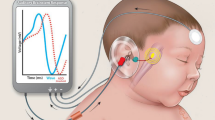Abstract
Auditory brainstem responses (ABR) were recorded in 30 normal and 60 high-risk neonates with gestational age between 30 and 45 weeks. The normative data of normal group as regard to age, sex and various parameters of ABR were compared with high-risk group. ABR parameters especially wave V and interwave V-I intervals were significantly prolonged in high-risk infants. An infant was considered to “pass” the ABR test if an identifiable and replicable wave V response was present at 30 dB HL in both ears. All the normal neonates had click thresholds consistent with normal hearing. 12 of the highrisk neonates showed mild to moderate hearing impairment (absent replicable wave V at 30–60 dB HL) and 2 of them showed severe to profound hearing impairment (absent replicable wave V at 70 dB HL). 9 of the “failed” group were reevaluated within 3 months and several times thereafter if the abnormal responses persisted. 2 (3.3%) infants showed persistent hearing loss, which was confirmed later by behavioral audiometry.
Similar content being viewed by others
References
Galambos R, Hicks G, Wilson M (1984) The auditory brainstem response reliably predicts hearing loss in graduates of a tertiary intensive care nursery. Ear Hear 5:254–260
Hall JW III (1992) Handbook of Auditory Evoked Responses. Boston, MA: Allyn & Bacon
Halpern J, Hosford-Dunn H, Malachowski N (1987) Four factors that accurately predict hearing loss in “high risk” neonates. Ear Hear 8:21–25
Joint Committee on Infant Hearing. 1994 position statement. ASHA 1994; 36:38–41
Kileny P, Magathan M (1987) Predictive value of ABR in infants and children with moderate to profound hearing loss. Ear Hear 8:217–221
Kramer S, Dianne R, Marie C (1989) Auditory Brainstem Responses and Clinical Follow-up of High-risk infants. Pediatrics 83(3):385–392
Lary S, Briassoulis G, De Vries L, Dubowitz V (1985) Hearing threshold in preterm and term infants by auditory brainstem response. J Pediatr 107(4):593–599
McClellan MS, Strong JP, Vautier T, Blatt L (1967) Otitis media in the newborn. Arch Otolaryngol 85:380
Shahnaz D, Charles MS, Kimberley KB, Ronald LG (1986) Neonatal screening with auditory brainstem responses: results of follow-up and risk factor evaluation. J Pediatrics 108(2):276–281
Stockard JE, Kleinberg F, Westmoreland BF (1984) Prognostic value of brainstem auditory potentials in neonates. Arch Neurol
Yang EY, Stuart A, Mencher GT, Mencher LS, Vincer MJ (1993) Auditory brainstem responses to Air- and Boneconducted Clicks in the audiological assessment of At-risk infants. Ear & Hearing 14(3):175–182
Author information
Authors and Affiliations
Corresponding author
Rights and permissions
About this article
Cite this article
Aiyer, R.G., Parikh, B. Evaluation of auditory brainstem responses for hearing screening of high-risk infants. Indian J Otolaryngol Head Neck Surg 61, 47–53 (2009). https://doi.org/10.1007/s12070-009-0034-4
Published:
Issue Date:
DOI: https://doi.org/10.1007/s12070-009-0034-4




